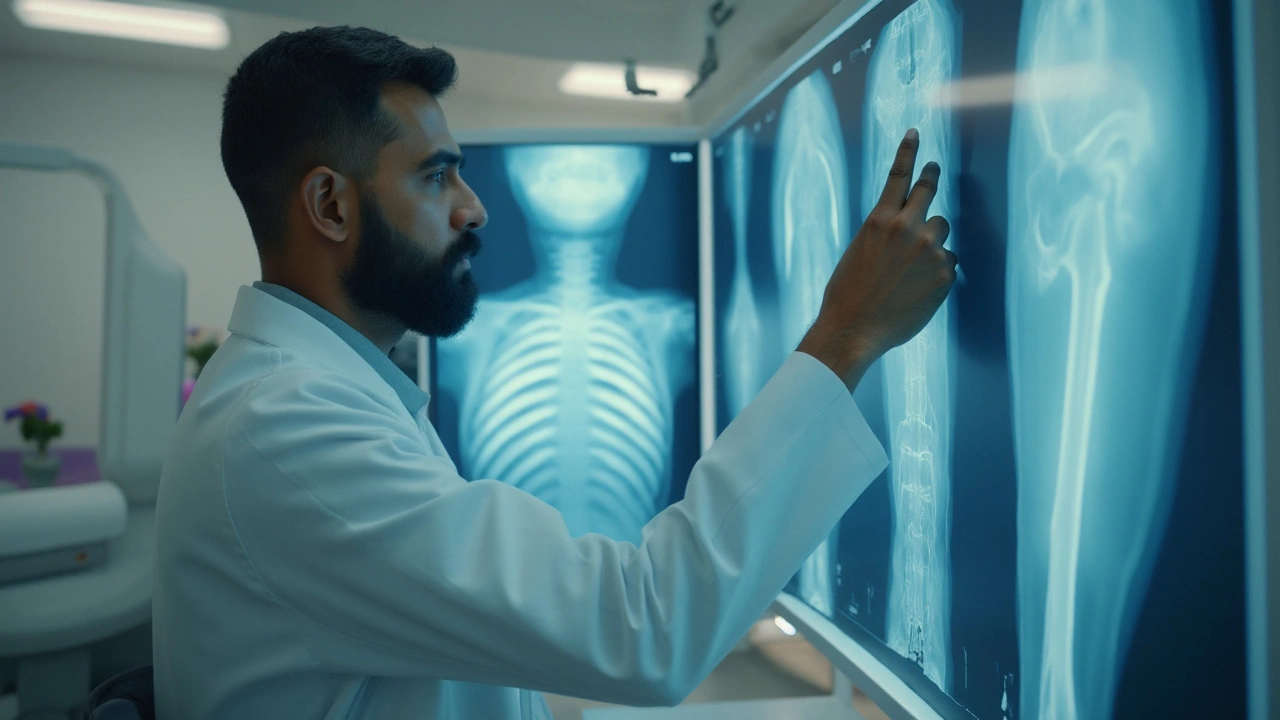When you're facing persistent joint pain or an injury that just won't heal, figuring out what to do next can be tough. You might wonder when is the right time to visit an orthopedic specialist. Orthopedic doctors focus on the musculoskeletal system, which includes bones, joints, ligaments, tendons, and muscles. Essentially, they're your go-to for any bone-related woes.
Let's dive into some of the scenarios where seeking an orthopedic referral is the wise move. Whether it's due to that nagging knee pain that stops you from enjoying a morning jog, or perhaps a concern over potential osteoporosis, understanding the right time to call in the specialists is key.
Getting the right help at the right time can make a world of difference in not only your treatment but also your recovery. There’s more to orthopedic medicine than just surgeries – these specialists offer a variety of treatments tailored to individual needs. So, let’s explore what you should know about seeing these fascinating doctors and how they can help you reclaim your quality of life.
- Signs You Need to See an Orthopedic Specialist
- Common Conditions Treated by Orthopedics
- The Role of Orthopedic Specialists
- Tips for Preparing for Your Orthopedic Appointment
Signs You Need to See an Orthopedic Specialist
Recognizing when to seek the expertise of an orthopedic specialist can significantly speed up your recovery and improve your quality of life. Many of us tend to ignore discomfort, thinking it's just a part of aging or everyday stress. But persistent issues with bones, joints, or muscles shouldn't be taken lightly. So, when should you really consider seeing an orthopedic doctor? First and foremost, chronic pain that lasts more than a few weeks signals the need for professional evaluation. Whether it's a dull ache in the hip or a sharp pain in the knee, if it keeps interfering with your daily activities, it’s time to pay attention. Pain is the body’s way of communicating that something isn’t right, and ignoring it can often lead to more serious problems.
Another key indicator is a limited range of motion. If you find it hard to move joints in the usual way, or perhaps you struggle to lift your arm high enough to reach a cabinet, these are not just signs of stiffness—they could indicate conditions like arthritis or even a rotator cuff tear. Orthopedic specialists are trained to assess mobility issues and propose interventions to restore or improve movement. Additionally, experiencing instability while walking or standing, which includes frequent falls or the sensation of joints giving out, should not be ignored. This kind of instability can lead to dangerous falls or injuries, particularly in older adults.
Swelling, bruising, or visible deformities, especially after a fall or accident, are also strong indicators that an orthopedic consult is necessary. These symptoms may point to fractures, sprains, or other injuries that require immediate treatment. According to a study published by the Journal of Orthopaedic Research, untreated joint injuries have a higher chance of developing into chronic issues over time. This piece of information reminds us why timely intervention matters. And let’s not overlook the instances when you've had a recent joint surgery or an orthopedic procedure. Follow-up care is crucial in these scenarios to ensure proper healing and gauge rehabilitation needs.
"It's crucial to seek orthopedic evaluation early. Late-stage referrals often miss the window for best recovery options," says Dr. Ramesh Gupta, a renowned orthopedic surgeon from India.
Finally, persistent soft tissue injuries should ring alarm bells. Sprains, strains, or tendonitis that don't improve with rest, ice, or over-the-counter pain relief in a reasonable period could have underlying issues that need specialized attention. Don’t play guessing games with your health. Consulting an orthopedic specialist can give you a comprehensive understanding of what's going on and an effective plan of action. They can offer personalized care plans, which might include physical therapy, medications, lifestyle modifications, or possibly surgical procedures if necessary.

Common Conditions Treated by Orthopedics
Orthopedics is a specialized branch of medicine that covers a wide array of conditions related to the skeleton and its supporting structures. One of the most common problems that bring people into an orthopedic's care is arthritis. This condition, which causes inflammation in the joints, can significantly reduce mobility and quality of life. Rheumatoid arthritis and osteoarthritis are two predominant forms, each requiring different approaches to treatment. These diseases can make common activities a challenge, and addressing them often involves a thorough evaluation and a mix of therapies including medication, physical therapy, and sometimes surgery.
Aside from arthritis, orthopedic specialists frequently see patients with back pain, a ubiquitous issue owing to our sedentary lifestyles and poor posture habits. This type of pain can originate from various sources such as herniated discs, spinal stenosis, or strained muscles and ligaments. Orthopedists often use diagnostic tools like MRIs or X-rays to get to the root of the problem before recommending a treatment plan. These might involve physical therapy exercises to strengthen core muscles, lifestyle modifications, or in some cases, surgical interventions to correct anatomical issues causing pain.
Injuries also make up a significant portion of orthopedic treatments. Sports injuries are commonplace in an orthopedist’s office, encompassing everything from ACL tears, common in athletes, to simpler sprains and strains. Overuse injuries like tendinitis or stress fractures are equally common and often affect those who participate in repetitive activities.
"At least half of all sports injuries, from fractures to ligament tears, can be prevented with adequate training and equipment," notes a study from the American Orthopedic Society for Sports Medicine.Careful assessment by a specialist helps in formulating rehabilitation programs that ensure safe return to activity without compromising future musculoskeletal health.
Orthopedics also deals with bone fractures, a critical area especially for young active individuals and elderly patients. Fractures can range from simple breaks to complex multi-fragmentary injuries requiring surgery. Bone health, particularly in older adults, is an essential aspect of orthopedic care. Conditions like osteoporosis, which leads to decreased bone density and increased fracture risk, are routinely managed by orthopedists. Treatment strategies often include lifestyle changes, medications, and sometimes the use of assistive devices to promote healing and prevent further injury.
Orthopedic care continuously evolves with the advancements in medical science, allowing for more efficient and effective treatments. Whether it’s advanced minimally invasive surgeries or comprehensive rehabilitation programs, orthopedics plays a pivotal role in enhancing patients’ lives. Moreover, the integration of technology in orthopedics, such as robotic surgeries and customized prosthetic devices, signifies a leap forward in personalized patient care. The field promises not only improved outcomes but also shorter recovery times, allowing individuals to quickly return to their regular lives and activities.

The Role of Orthopedic Specialists
Orthopedic specialists hold a pivotal place in the medical field, focusing on a realm that is fundamental to our mobility and strength: the musculoskeletal system. These experts are extensively trained to address an array of conditions affecting bones, joints, ligaments, muscles, and tendons. Their role goes far beyond merely treating sports injuries or performing surgeries. It encompasses a diverse spectrum of responsibilities, all aiming to enhance bone health and provide relief from joint pain.
Orthopedic specialists employ various diagnostic tools to diligently assess a patient's condition. They often rely on advanced imaging techniques such as X-rays, MRIs, and CT scans to pinpoint the exact cause of discomfort. These tools enable them to detect fractures, arthritis, or even diseases like osteoporosis with precision. Therefore, it's not just about what they can see; it's what they can interpret through these images to create an effective and individualized treatment plan.
The treatment approaches by an orthopedic specialist are equally diverse. While some conditions might merely require rest or immobilization, others could benefit from physical therapy, a non-invasive method to strengthen the biomechanical framework. Orthopedic experts might also recommend minimally invasive procedures to repair tendon damage or mitigate joint degeneration. In cases where conservative treatments don't yield the desired results, surgical interventions become necessary. With advancements in medical technology, orthopedic surgery today minimizes recovery time and maximizes functionality, a testament to their crucial role in healthcare.
According to the World Health Organization, orthopedic conditions are a leading cause of disability worldwide, underscoring the importance of these specialists. It's fascinating to learn that orthopedic surgery is one of the most quickly advancing fields, with specialists constantly learning and adapting to new practices and technologies that enhance patient care.
"Orthopedic care is rapidly evolving, and the development of novel implant materials and surgical techniques is revolutionizing how we address bone and joint issues," says Dr. John Smith, a renowned orthopedic surgeon with over two decades of experience.
Further diversifying their roles, orthopedic specialists pay substantial attention to patient education. Educating patients about maintaining bone health, the importance of calcium and vitamin D in diets, and ergonomics at work and home are some areas where they guide with precision. Additionally, they might recommend lifestyle changes that mitigate risks associated with cardiovascular diseases, thereby improving a patient's holistic health.
The ability of orthopedic specialists to amalgamate science with compassion cannot be understated. By delving into cutting-edge research and technological advancements, they continue to push the boundaries, ensuring patients don't just recover but thrive post-treatment. They remain integral, not just in enhancing recovery or providing pain relief but in seriously improving the overall quality of life for many.

Tips for Preparing for Your Orthopedic Appointment
Your first visit to an orthopedic specialist might feel a bit daunting, but with the right preparation, it can turn out to be an enlightening and beneficial experience. It's not just about showing up and discussing symptoms. There's more to it. Start by gathering all your relevant medical records, including any previous X-rays, MRI scans, or lab results that pertain to your current condition. This allows your orthopedic doctor to see the full picture, giving them a better understanding of your bone health. Make sure to jot down any questions or concerns you have ahead of the appointment to ensure nothing slips your mind during the consultation.
Wearing appropriate clothing is also crucial when you're visiting an orthopedic specialist. Depending on the nature of your visit, the doctor might need to examine certain areas closely. Opt for loose clothing that can easily be adjusted to provide access to any necessary parts of the body while maintaining your comfort and privacy. Remember, sometimes simplicity is key, and choosing the right outfit can save time and make your visit smoother. Also, try noting when and where your pain occurs and its severity. Tracking these nuances can give your doctor valuable insights. As per Dr. Joseph Zuckerman, a noted orthopedic surgeon, "Paying attention to the details of your pain can guide effective treatment."
"Patients who prepare for their orthopedic appointments by tracking their symptoms are often more satisfied with their treatment outcomes." - Dr. Joseph Zuckerman
Also, a good mental preparation involves setting realistic expectations. You're likely to encounter a range of potential treatment options, from medication to physical therapy, and perhaps even surgery. Understanding that each step is part of a larger journey can ease anxiety. Don't hesitate to bring someone along if you feel the need. A family member or a friend can provide emotional support, and also help in recalling the doctor's advice later. They might also think of questions you hadn't considered, aiding a more comprehensive discussion about your joint pain or any other concern.
Lastly, if possible, contact the clinic in advance to learn about required paperwork or any specific instructions you need to follow before the appointment. This forward-thinking attitude ensures that you won't encounter any last-minute hurdles on the day of your appointment. Preparing completely minimizes stress and maximizes the productivity of your visit, helping you set a clear path towards recovery and better health.





